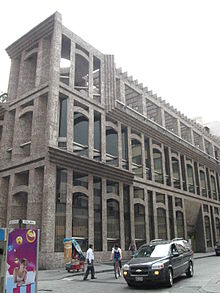Grupo Financiero Banamex
This article has multiple issues. Please help improve it or discuss these issues on the talk page. (Learn how and when to remove these template messages)
|
| Company type | Subsidiary |
|---|---|
| Industry | Financial services |
| Founded | 1882 as Banco Nacional de México (Banamex) |
| Headquarters | Mexico City, Mexico |
Key people | Roberto Hernández Ramírez, (CEO) |
| Products | Banking, Financial |
| Revenue | |
| Total assets | |
Number of employees | 40,000 |
| Parent | Citigroup |
| Website | www.banamex.com |
Grupo Financiero Banamex S.A. de C.V. has its origins and is the owner of Banco Nacional de México or Banamex, Mexico's second largest bank behind BBVA Bancomer. The Banamex Financial Group was purchased by Citigroup in August 2001 for $12.5 billion USD. It continues to operate as a Citigroup subsidiary.
History

Banamex was formed on June 2, 1884 from the merger of two banks, Banco Nacional Mexicano and Banco Mercantil Mexicano, two banks that had operated since the beginning of 1882. The newly founded bank had branches in Mérida, Veracruz, Puebla, Guanajuato and San Luis Potosí, and opened a branch in Guadalajara.
In 1916, General Pancho Villa's revolution interrupted the bank's role as banknote issuer for the Porfirio Díaz regime.
The bank was reorganized in 1926, becoming a financing bank and establishing the first agency of a Latin American bank in New York.
Banamex gradually introduced several financial product innovations to the Mexican market including savings accounts (in 1929), personal credit lines (in 1958), credit cards (in 1968), and ATM banking (in 1972).
In 1981, the California Commerce Bank was acquired by Banamex.
In the midst of a severe economic crisis (1982), President José López Portillo announced a major devaluation of the peso and nationalized all private banks in Mexico. For the next nine years Banamex operated as a government owned national credit association.
In 1991, Banamex was reprivatized and it established Grupo Financiero Banamex–Accival with the investment bank Acciones y Valores de México (Accival).
For the next four years Banamex and the rest of the Mexican private banks presided over an unprecedented expansion of private credit in Mexico. This expansion occurred in an environment characterized by: i) the lack of a credit culture at the newly privatized banks, which had been bought at rich multiples by individuals and organizations without lending experience, and ii) lax oversight by regulatory authorities, which led in some instances to the occurrence of irregular transactions (such as related party transactions).
The result of this aggressive expansion of credit was to strain the bank's balance sheet (loan portfolio quality ratios and capitalization ratios). The December 1994 macro-devaluation of the Mexican Pesos (see the December Mistake) and the ensuing significant increase in domestic interest rates coupled with a dramatic economic recession, caused Banamex's and much of the rest of the privatized banks to essentially become insolvent.
In order to avoid the potentially catastrophic effects of generalized bank bankruptcies, the Ernesto Zedillo administration decides to rescue the troubled banks through a government fund (Instituto de Protección al Ahorro Bancario or IPAB, later called Fondo Bancario de Protección al Ahorro or Fobaproa). IPAB enticed the banks' shareholders to inject fresh equity into the banks by pledging to buy from the banks non-performing loans in a two to one (or in some cases greater) ratio with respect to the newly injected fresh capital in exchange for a long-dated government note with capitalized interest.
Banamex eventually sold $_ worth of non-performing loans to IPAB, and its shareholders injected $_ of fresh equity. The combination of these measures coupled with a recovery of the Mexican economy helped clean-up the bank's balance sheet.
From 1997 to 2001 Roberto Hernández Ramírez was the CEO. In 1997 Afore Banamex was created to tap into the newly created private pension fund market.
On August 6, 2001, Citigroup Inc. acquired Grupo Financiero Banamex-Accival for US$12.5 billion, which became Grupo Financiero Banamex. This was the largest-ever U.S.-Mexico corporate merger. Grupo Financiero Banamex's operations were integrated with Citibank's relatively small existing Mexico business under the Banamex brand name. Manuel Medina Mora current CEO of Latin America.
Subsidiaries

The following are subsidiaries of Grupo Financiero Banamex:
- Banamex http://www.banamex.com
- Fondos Horizontes Banamex http://www.fondoshorizontes.com & http://www.fondoshorizontes.com.mx
- Bancanet https://boveda.banamex.com.mx
- Brokerage House Accival http://www.accival.com.mx
- AcciTrade http://www.accitrade.com http://www.accitrade.com.mx
- Seguros Banamex http://www.banamex.com
- Grupo Aeroméxico http://www.aeromexico.com
- Afore Banamex http://www.banamex.com
- Inteligia, joint venture with Accenture to provide software outsourcing
- California Bank of Commerce (recently changed its name to Citibank Banamex USA) http://www.ccbusa.com

